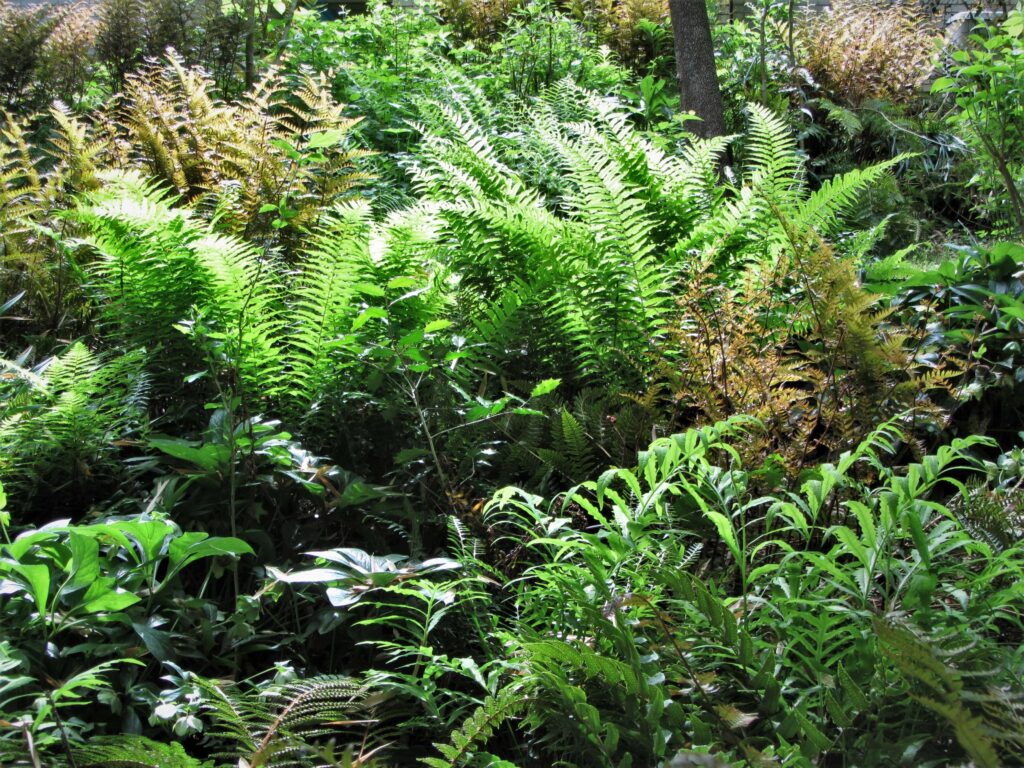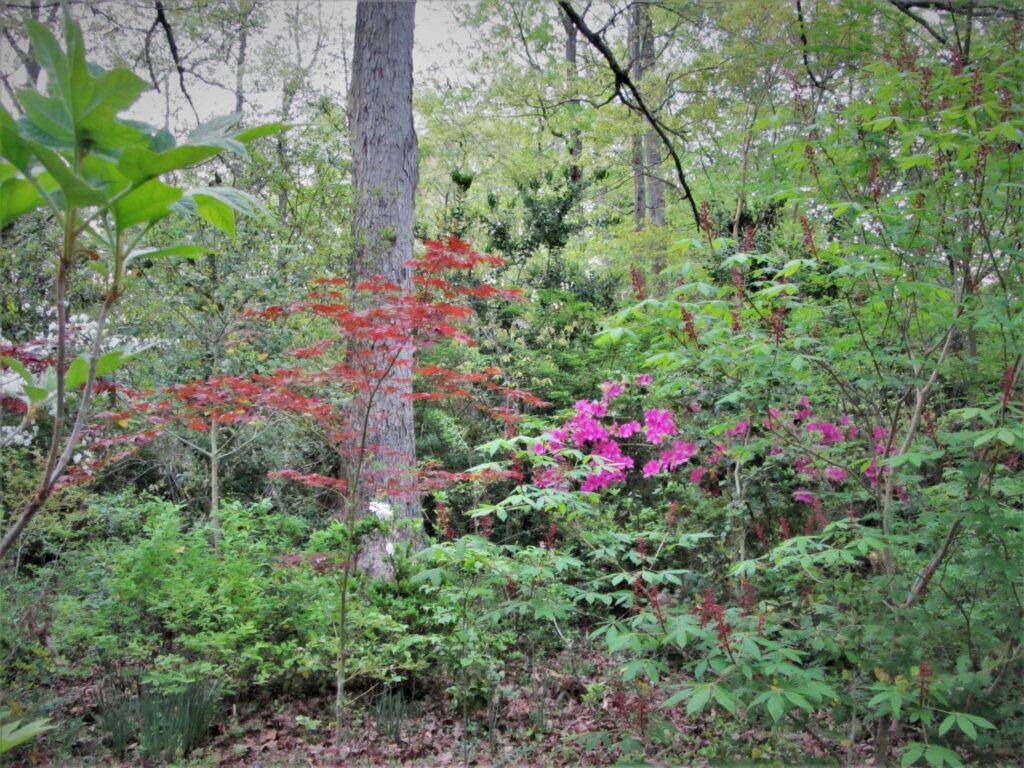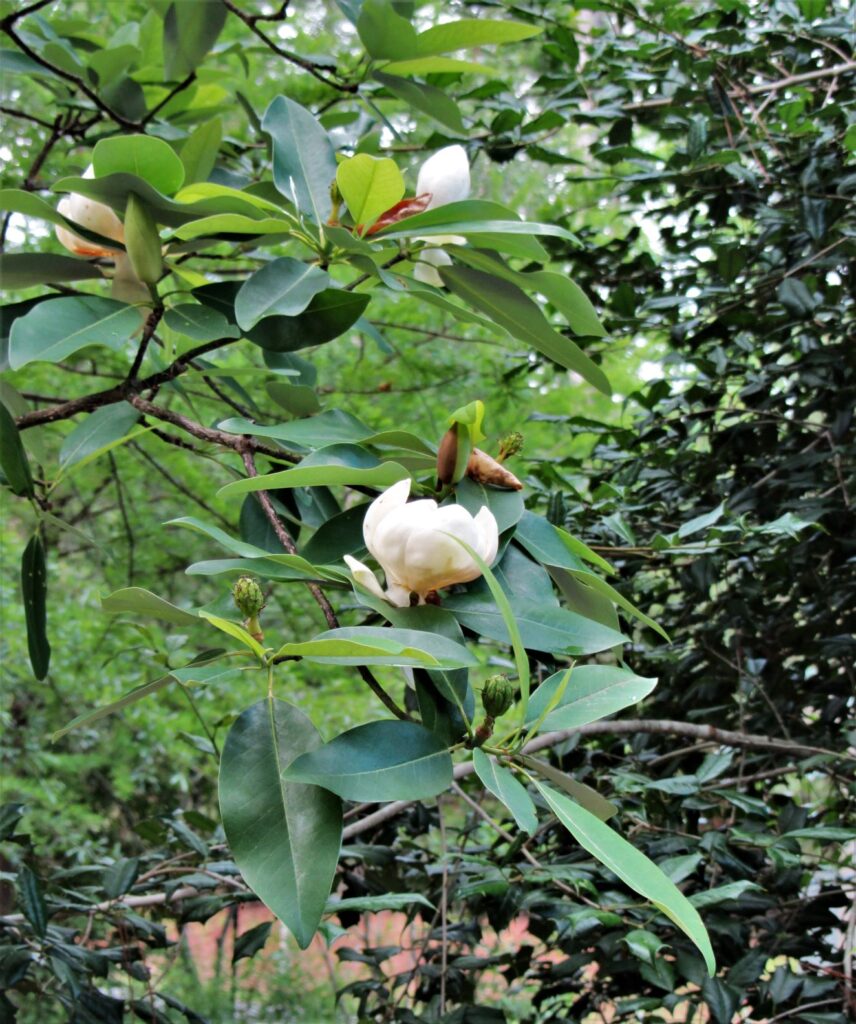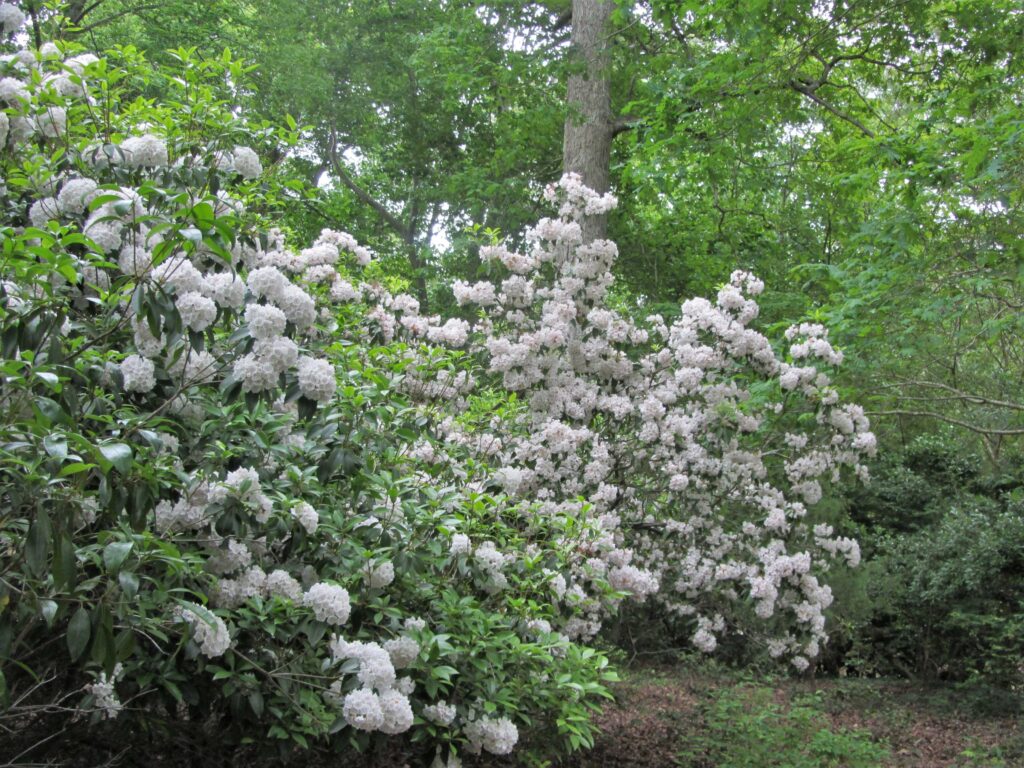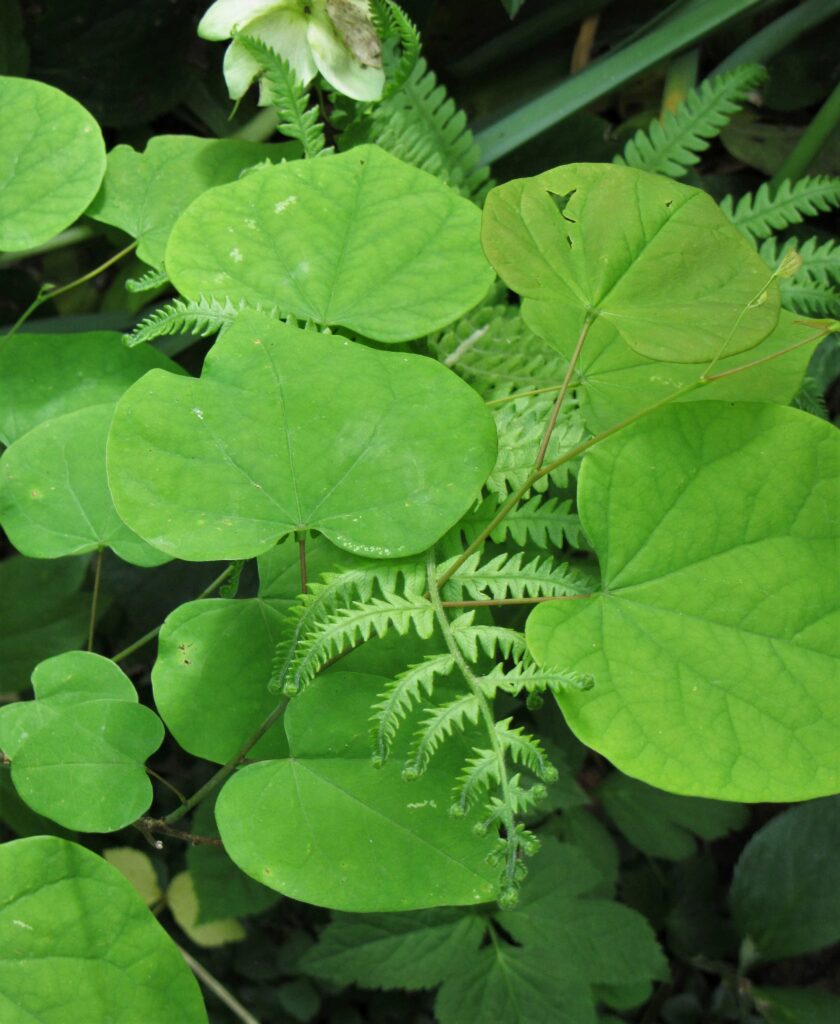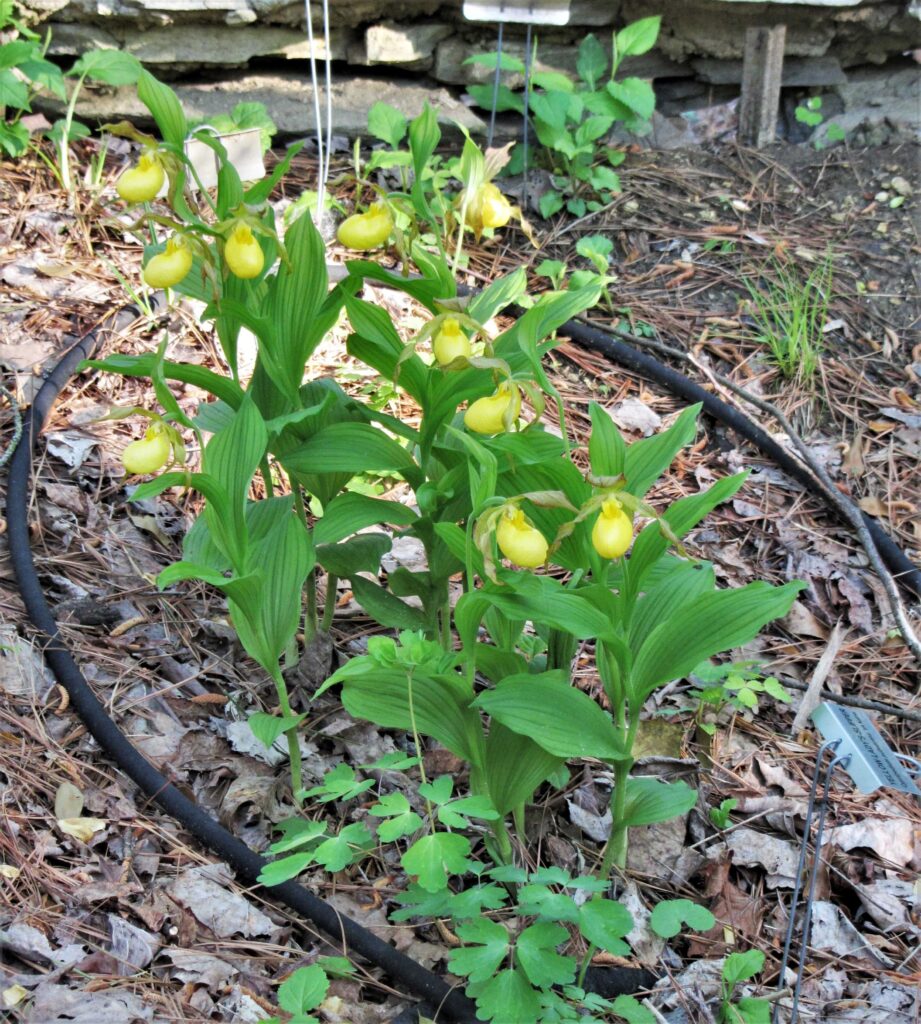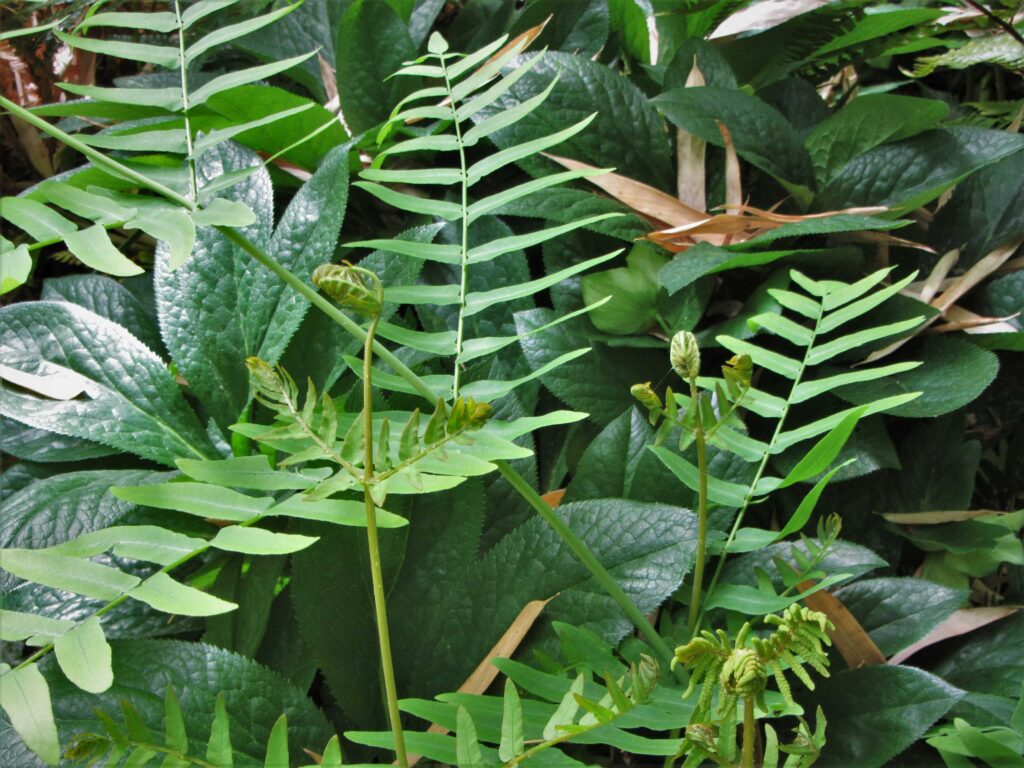Sustainable Gardening in the Shade
When you’re planning a new garden, do you look for a sunny spot or for a bit of shade? That used to be an easy decision. We all know that plants need good light to grow well. Gardening books used to advise anyone planting a small vegetable garden or flower bed to watch how the sun moves across the sky and how the shadows fall across their yard to select a good sunny spot to break ground. Traditional gardeners have been willing to prune a few limbs or even cut down a tree or two to provide more sunlight for their gardens.
Shade gardeners will do the opposite. We seek out the shady moist spots in our yard, and often plant new trees and large shrubs to create more shade around our homes. Why would anyone want to create a garden in the shade?
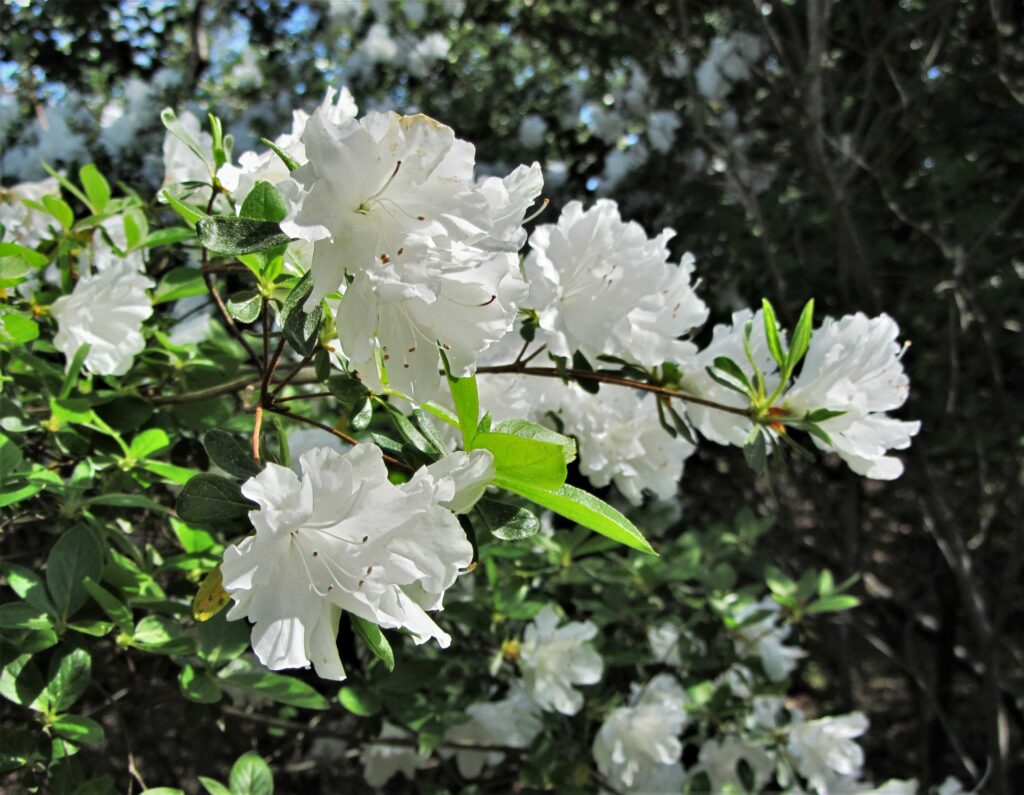
All Rhododendron species, including Indica hybrid Azaleas, perform well in bright shade and moist, acidic soil.
That answer comes easily to anyone who has spent a sunny summer day mowing the grass or working in their sunny vegetable garden. It gets wicked hot out in the sun. And as our weather grows a bit more intense with each passing year, we have more days of high heat and intense sunlight. Hot days may start earlier in the spring and last longer into the autumn. Temperatures reached 90F or more in Williamsburg on 50 days during 2022. Each year we break records for ‘hottest day ever’ on a particular date, and each year may feel hotter overall than past years. More than a dozen of those daily heat records were broken in Virginia between June 1 and September 7, 2022.
Intense heat and high humidity make it more challenging to work outside. But you can feel a significant difference between a shady spot and an area of full sun on hot days. The shade feels like such a relief, cooler and without the burning feeling of standing in direct sunlight.
While comfort is important, staying healthy is even more important. Working in full sun without adequate skin and eye protection invites a range of unpleasant health problems. Especially while the sun is high in the sky, we require sunscreen and protective clothing to work out in the sun these days. Working in the heat is hard on our heart, and when we stay at it too long, dehydration, heat exhaustion and heat stroke become a risk. Many feel the effects of working in heat and sun more as they age.
Cultivating a shady garden offers us some protection from summer heat and direct sun. Harmful rays may be captured by trees or blocked by walls or other garden structures before they can reach us. We can work longer, later into the day, and in greater comfort.
Degrees of Shade
But what about the plants? Will anything useful grow in the shade? There are degrees of shade, and a surprisingly large selection of plants will grow just fine in ‘partial sun’ or bright shade. Even plants that require ‘full sun’ will often grow well in just 6-8 hours of direct sun each day. As heat builds in the summer, even ‘full sun’ plants often do better with a bit of shade, particularly in the afternoon. Too much heat and sun increase the stress on plants just as they do on people.

Iris tectorum blooms in bright shade with just a few hours of direct sun daily. Lamium maculatum serves as an ornamental ground cover in this area of the garden.
Bright sunlight speeds evaporation of water from both plants and soil. You may notice some plants wilting in the afternoon sun. Even when there is moisture in the soil, the plant may not be able to absorb and move enough water to its extremities to prevent some leaves from wilting. Providing shade, mulch and living ground cover helps the soil retain more moisture, reducing the need for supplemental irrigation during dry spells.
The light shade cast by a high canopy of translucent compound leaves, like those of a locust or mimosa tree, has a much different quality than shade under the canopy of a Southern Magnolia. The Magnolia’s leaves are thick, broad and block out much more of the sunlight. Areas of sun, and the shade cast by structures and trees, is constantly changing as the sun moves across the sky each day and as the seasons turn. There are brighter areas where direct sunlight reaches for some period each day. Areas under deciduous trees may be planted with flowering bulbs and early perennials that finish in the spring before the leaves above them fill in.
Shade on the northern side of a building or wall has a different, denser quality than shade cast by trees. Canopies, awnings, umbrellas, and pergolas provide lighter and more temporary areas of shade. It is helpful to think in terms of the ratio of sun to shade, the timing of the shade, and the degree of shade when planning shade garden plantings. Many perennials and shrubs tolerate direct morning sun, but wilt and crisp in the stronger afternoon light.
Where yards are small and homes are close together, one’s outdoor space may be shaded for much of the day. Even in deep shade, where there is little or no direct sun at any time of day or year, there are plants that will thrive. Even if a concrete pad fills the area, large containers can still support a beautiful shade garden. Large containers holding a community of plants are easier to maintain than a collection of small containers, because they provide more space for roots and retain moisture longer.
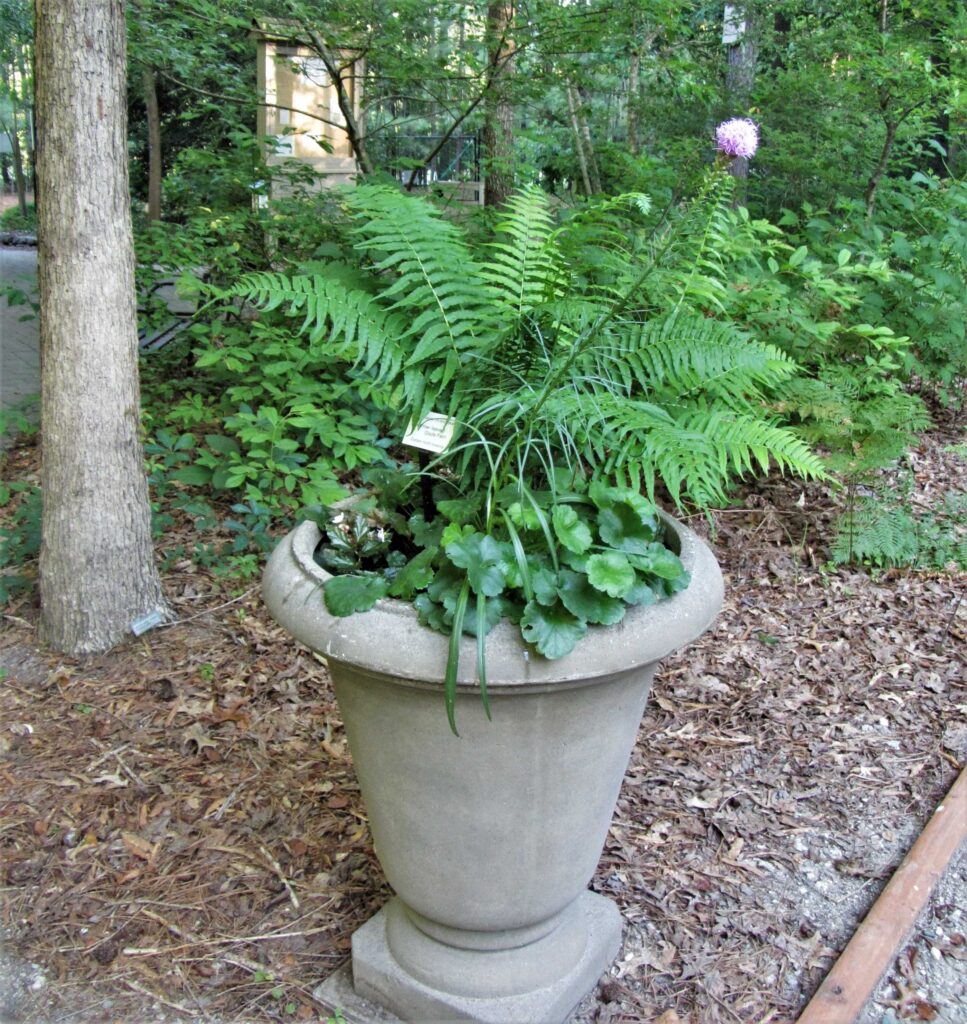
Homalosorus pycnocarpos, Glade fern, grows happily in a large urn with Heuchera, Lyatris and Begonia.
Shade gardeners soon discover that there are more shade tolerant choices among genera traditionally considered as needing full sun. There are shrub and climbing roses that will thrive in bright shade. Other genera, like Iris, have species that prefer shade to sun, and many traditional flowering perennials will still flower in less than the 14 hours or more of direct sun of a summer day. A bit of experimentation reveals that we can bend all sorts of gardening rules, especially those rules about how much light a particular plant requires. When in doubt, plant in a container first. The container can be moved around until the plant is sited where it can thrive.
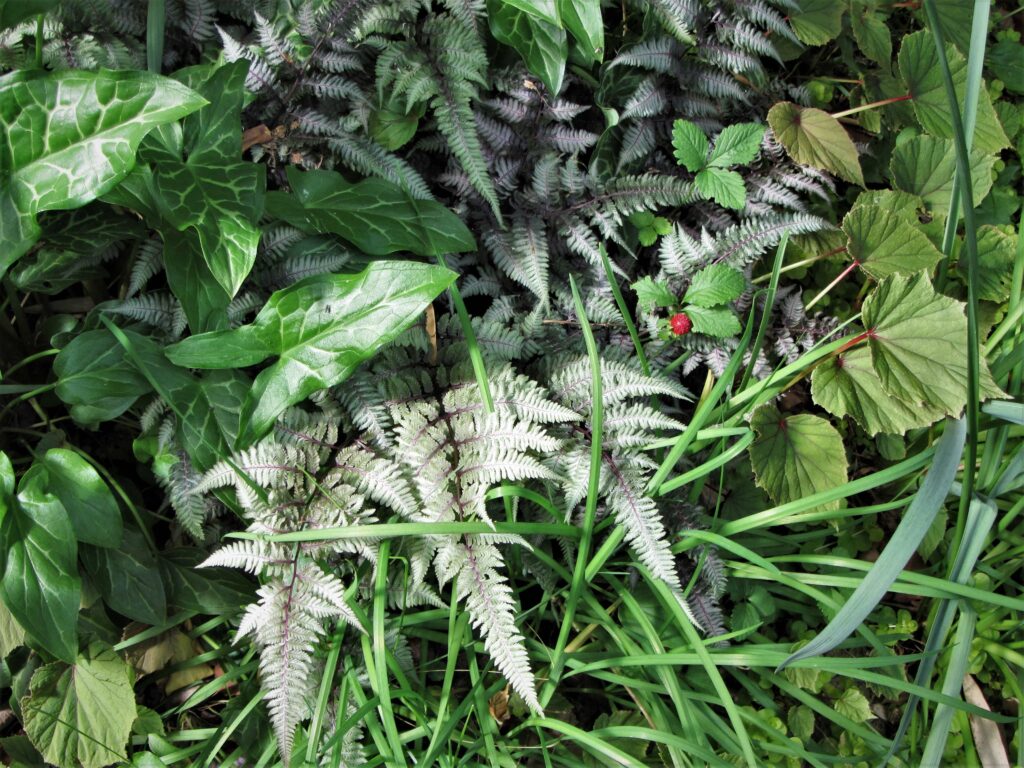
Japanese painted fern, Athyrium niponicum, grows in the shade of several crape myrtle trees mixed with hardy Begonia grandis, spring blooming Narcissus ssp. and Arum italicum. Italian Arum fades in early summer, leaving room for the Begonias to grow.
Layering Plantings
Building layers of plantings ultimately absorbs more sunlight and more carbon and nitrogen from the air than growing just a single layer of plants near the ground. Wide expanses of lawn or monoculture crops can’t clean and filter the air nearly as well as multiple layers of trees, large shrubs, herbaceous plantings, and ground cover plantings can filter the air. The plants also release moisture and clean oxygen into the air during their respiration. All of that beautiful sunlight can be captured and used to power food production and carbon sequestration in a multi-layered, shady garden. After all, it is only shady at ground level. The upper layers still grow in bright sunlight.
Mature trees form the canopy layer, while providing food and habitat for many species of birds, insects, and small mammals. Many of these canopy layer trees are keystone ‘host’ species that support hundreds of species of insects and other animals. Animals also appreciate and need the shade and shelter that trees provide. Canopy trees are growing in ‘full sun,’ absorbing a portion of the available solar radiation before it reaches the ground. Tall deciduous trees create ‘bright shade,’ with patches of ‘full sun’ moving around the perimeter of their shadows throughout the day.
Understory trees, like dogwoods, redbuds, oakleaf Hydrangeas and Japanese maples create smaller areas of shade, but can create zones of deeper shade under large canopy trees. Large shrubs, like Camellias, mountain laurel, Viburnums and hollies, may be mixed among the understory trees. Evergreen shrubs, and those with denser vegetation, will create areas of much deeper shade under and around them. Many canopy trees will grow in even dense shade as seedlings. The shade cast by larger trees encourages them to gain height quickly as they reach for the available light.
Low, ground cover plants absorb whatever light can reach them while also sequestering carbon and other gasses. They shade the soil, protect against erosion, and provide habitat for insects, birds, and small mammals. Some ground cover plants, like native strawberries, Fragaria virginiana, and partridge berry, Mitchella repens, also produce nectar and small fruit.
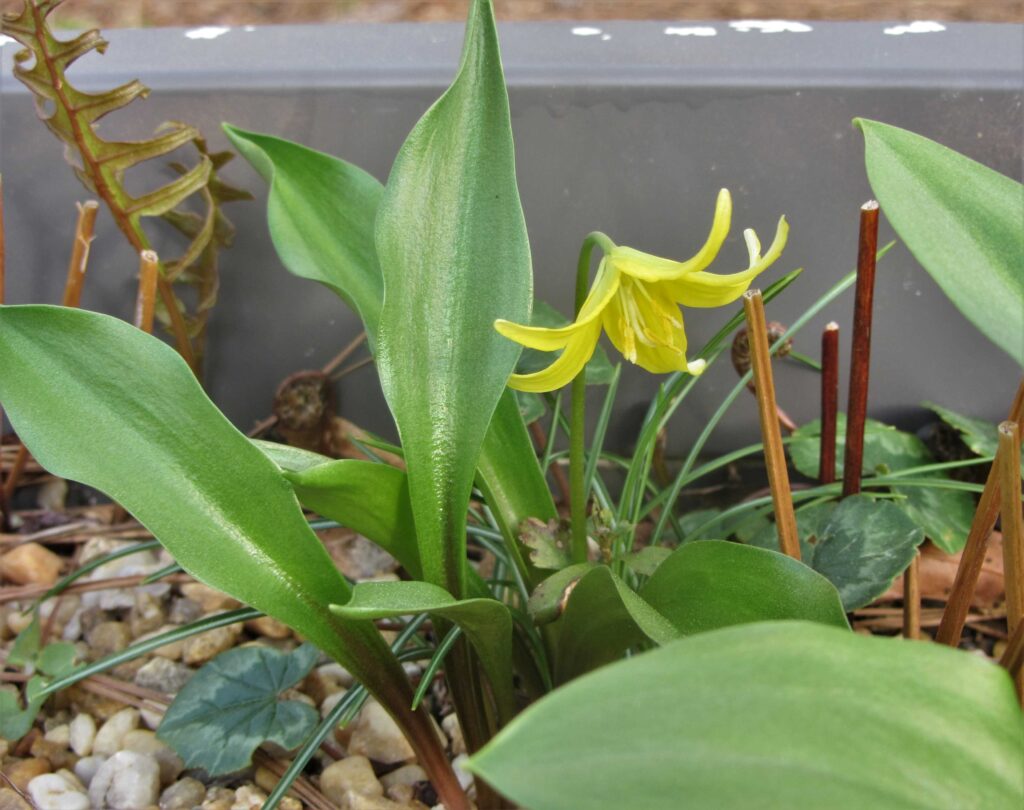
Native Erythronium, americanum, known as ‘Dogtooth Violet’ for the shape of its corm, is a spring blooming ephemeral that grows well in deep to partial shade. The variegated leaves are Cyclamen coum and Crocus.
Ground Covers and Mulches
Evergreen ground cover plants continue to function throughout the year while deciduous ones disappear in autumn, possibly leaving the ground level unprotected and subject to erosion through the winter. Mulches protect the ground from erosion and look nice, but they don’t continue to absorb and sequester carbon.
Decaying organic mulches, like bark and pine straw, can release carbon back to the atmosphere. In areas where you grow deciduous plants, consider mulching with gravel instead. Gravel is durable, attractive, and holds sequestered carbon in the ground. Moss creates an elegant, living ground cover. Cultivate moss on low-traffic paths and in open areas as a sort of evergreen, low maintenance shady ‘lawn.’
Evergreen and herbaceous perennials may also serve as ground cover. Plants like Hellebores, evergreen ferns, Epimedium ssp., Vinca minor, Ajuga, and mondo grass or Liriope provide evergreen winter ground cover in shady areas. Shade gardeners know the difficulties of trying to grow a traditional lawn in the shade. Lawn grasses want full sun, and don’t grow well under trees. Tree roots don’t fare well under lawn, either. Alternatives to lawns are worth exploring for shady garden areas.
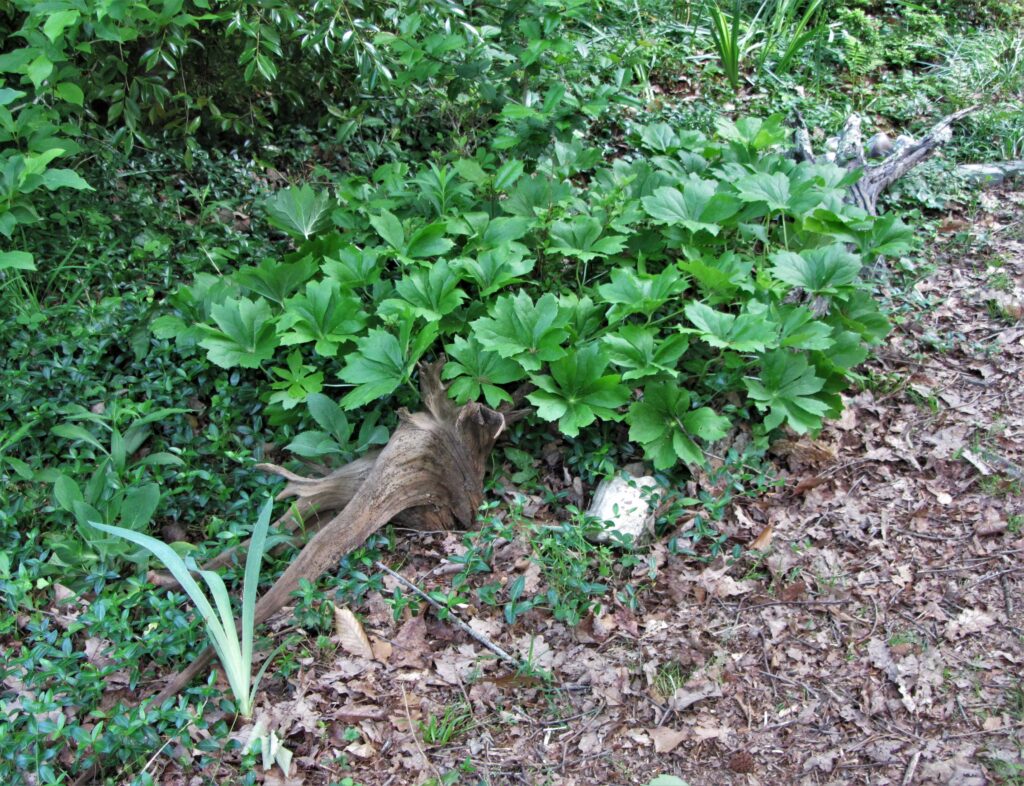
Mayapple, Podophyllum peltatum, grows into a dense ground cover each spring, but fades by mid-summer. Evergreen Vinca minor is an evergreen ground cover vine that blooms in early spring.
Design with Colorful Foliage
There is an extensive palette of colorful plants available for shady gardens. Foliage plants perform better over time than those grown mostly for their flowers. Some shade loving plants like Lamium maculatum, Heuchera ssp. and Ajuga ssp. will bloom in late spring when more light is available, and then persist primarily as a foliage plants through the summer after the canopy fills in. Plants grown mostly for their foliage, like Caladiums, ferns, Coleus, Hosta, and Begonias remain beautiful throughout the entire season. While flowers come and go, beautiful leaves may persist for many months.
Variegated plants generally perform better in the shade. Many shade loving plants have intricate patterns and designs on their leaves, and their leaves may be silver, purple, red, pink, gold, nearly black, or cream, as well as various shades of green. There are some unusual and beautiful variegated plants to enjoy only in shade. Try growing Asarum ssp., Cyclamen ssp., Tiarella cordifolia, Saxifraga stolonifera, Brunnera macrophylla, Athyrium niponicum, or Begonia rex. Beautiful combinations of color and form result from mixing these very ornamental plants.
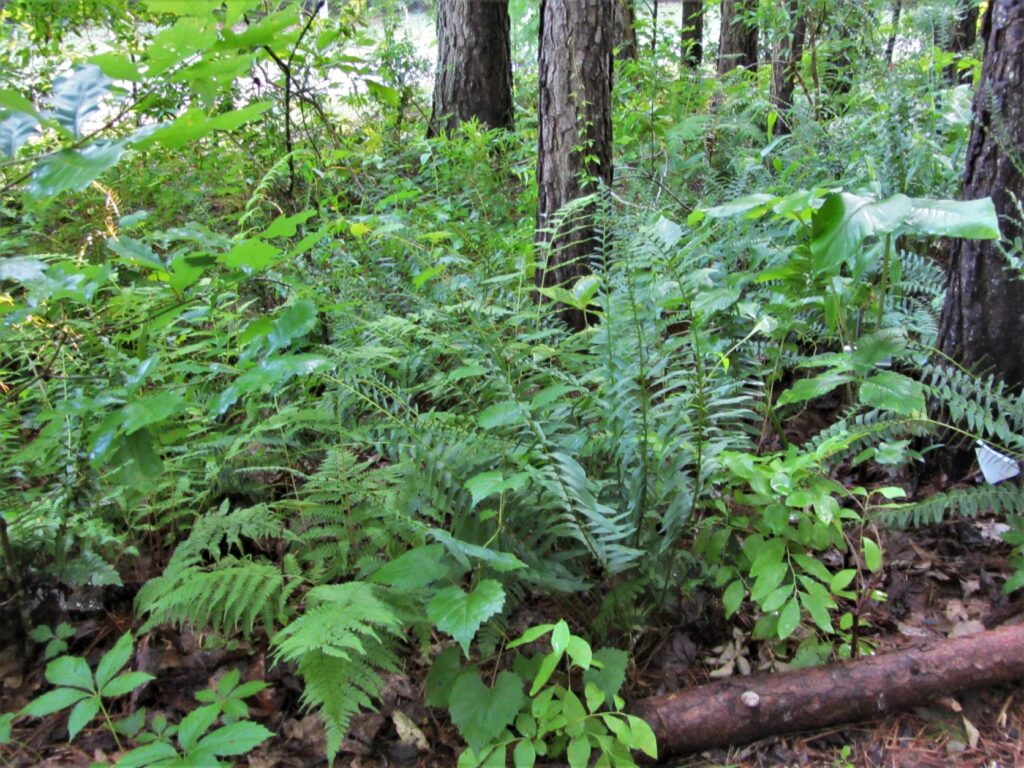
Ariasaema tryphyllum, Jack-in-the-pulpit, grows in among ferns in this wooded section of the Williamsburg Botanical Garden.
Provide Habitat for Ephemeral Native Plants
Some ephemeral native plants, like orchids, Trillium, trout lily, Jack-in-the-pulpit, and native ginger are becoming endangered as their habitat is destroyed. Shade gardens allow us to cultivate and preserve these, and other species, that may be lesser known than some of the sun-loving native plants.
Gardening in Dry Shade
One of the greatest challenges for traditional gardeners is the dry, shallow soil often found in the shade of walls and large trees. Many times, the soil beneath large trees is bare, patchy with weak grass or weeds, or simply covered with fallen leaves and sticks. Decaying leaves return important nutrients to the soil as they form an effective organic mulch.
There are areas in wooded yards where simply leaving the leaves as they fall is the best practice. Alternatively, raking the leaves into piles away from exposed roots and then running over them with a mulching mower creates a finer texture. The resulting leaf mulch can then be raked or blown back over the root zone to slowly decay into rich soil. Fallen leaves are important to feeding the many organisms that live in the soil, and to preserving its chemistry.
Sticks and ‘edited vegetation’ (weeds) also feed the soil. Sticks may be used as the base layer in new raised beds. They can be chipped into small pieces and added to mulch. Weeds wilt quickly once cut or pulled. “Chop and drop” isn’t pretty, but is a functional way to immediately use grass and other green vegetative clippings as ground cover. They enrich the soil with the minerals stored in their tissue as they decay and feed microbial and invertebrate life in the soil. This is the natural process for building rich, organic soils under trees.
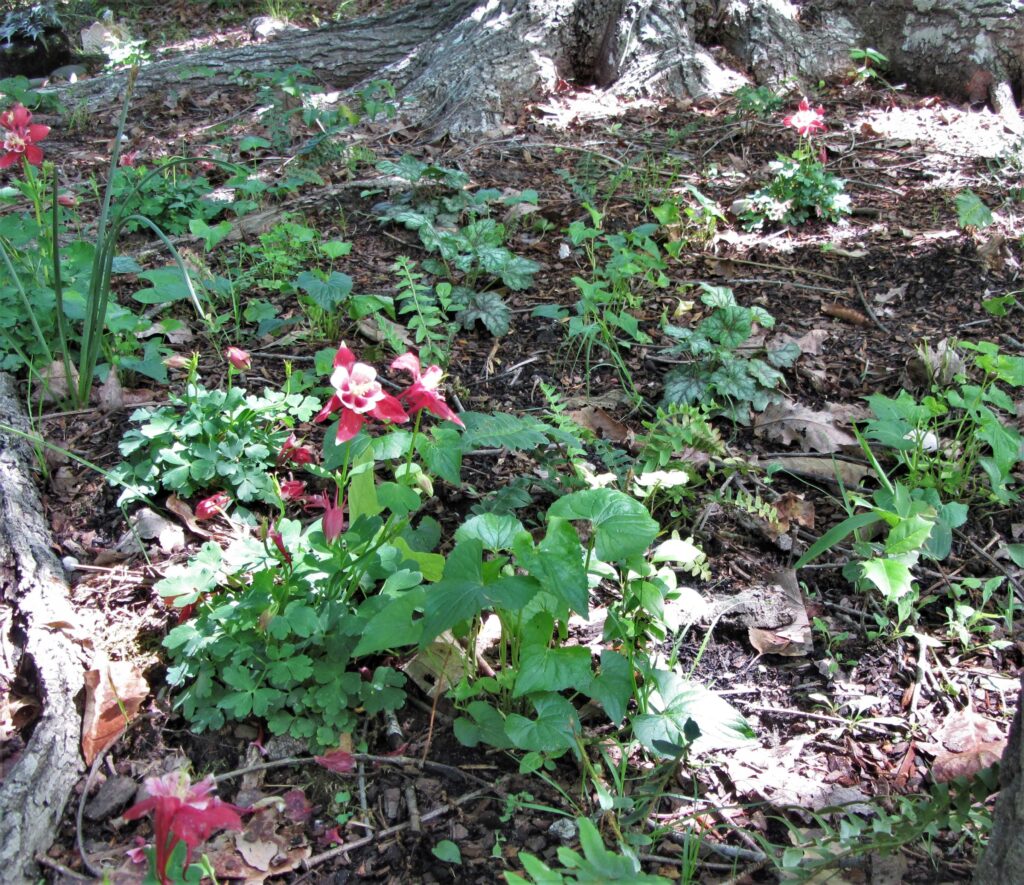
Plant plugs in the smallest holes possible between roots, and mulch the area lightly to establish perennials in dry shade. Christmas ferns, native Viola sororia, Aquilegia hybrids, and Heuchera hybrids perform well in dry shade.
Many plants will thrive under trees without interfering with the tree’s growth. Plant small, plug sized ferns, or hardy, shade-loving perennials in small holes dug between the roots. Just make sure the plants you choose have low to moderate water needs, once established. Expect to irrigate during dry spells during the first year. Grow thirstier plants in containers. Containers allow the gardener to provide deep, rich soil that can be easily fertilized without interfering with a tree’s roots. Just place the containers several inches away from the trunk and from any exposed roots.
Creating a garden in the shade allows us to design comfortable outdoor areas to relax, entertain, and putter in our gardens in comfort. Shielded from harmful rays from the sun, we can cultivate a haven for wildlife and for ourselves. Our gardens function to conserve water while scrubbing and sequestering carbon dioxide from the air. Shade gardens are places of rare beauty, filled with layers of color, texture, and ephemeral seasonal plantings. They continuously change as plants fill in and the light changes year to year and season to season.
All Photos by E. L. McCoy

Dryopteris erythrosora ‘Brilliance’ emerges with copper fronds each spring, and they slowly turn green as they mature. It grows here with native Onoclea sensibilis, the sensitive fern, and Polystichum acrostichoides, the evergreen Christmas fern.
To Learn More:
Culp, David L. The Layered Garden: Design Lessons for Year-Round Beauty from Brandywine Cottage. Timber Press. 2012.
Druse, Ken. The Natural Shade Garden. Clarkson Potter. 1992.
Druse, Ken. The New Shade Garden: Creating a Lush Oasis in the Age of Climate Change. Stewart, Tabori & Chang. 2015.
Hodgson, Larry. Making the Most of Shade: How to Plan, Plant, and Grow a Fabulous Garden that Lightens up the Shadows. Rodale Books. 2005.
Wiley, Keith. Shade: Planting Solutions for Shady Gardens. Timber Press. 2007.

